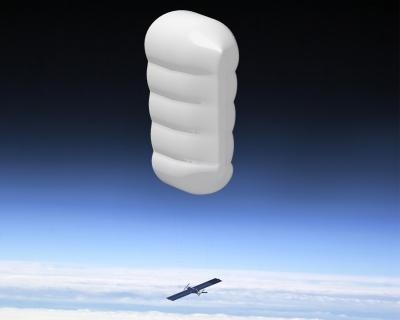Four Months On-station Persistence Predicted
Global Near Space Services (GNSS) of Colorado Springs, CO, and
Bye Aerospace of Denver, CO, jointly announced continued progress
in the development of a unique solar-electric-powered airship named
StarLight. Engineers project this cost-effective, unmanned high
altitude airship will remain on-station in the stratosphere for a
minimum of four months at a time. It will have an unprecedented
capability to provide affordable persistent wide-area sensing and
communications for both commercial and government purposes. Phase 1
and Phase 2 of development of the stratospheric airship was
conducted under the supervision of the Naval Air Systems Command
(NAVAIR), Aircraft Division.

Ron Oholendt, President of GNSS, said the joint GNSS-Bye
Aerospace engineering team approach is unique. “The program
leverages proven, commercially developed and environmentally
friendly technologies that are going to produce high altitude
flight durations measured in months instead of hours,”
Oholendt said. “A thorough analysis shows that flying hour
costs will be less than one-tenth the cost of current high altitude
aircraft and UAVs.”
GNSS and Bye Aerospace plan subscale flight demonstrations to
illustrate the efficiency of solar electric power technology,
vehicle performance and control at high altitude. The all
solar-powered "StarLight™” high altitude, long
endurance UAV system will carry advanced technology wide area
sensors and communication systems to altitudes surpassed only by
ultra-high altitude free-floating balloons and rockets that launch
satellites into space. Preliminary design of the uniquely shaped
airship upper stage is complete. The sub-scale lower stage has
completed a critical design review and the subsystems have been
assembled and tested.
The lower stage solar electric hybrid vehicle engineered by Bye
Aerospace provides vehicle control and propulsion for non-tethered
station keeping. “This new LTA (lighter than air) UAV
category is made possible by advancements in lightweight efficient
flexible thin film solar energy collection, electric propulsion
technology and lightweight composite structures,” said George
Bye, CEO of Bye Aerospace. “In combination with very high
altitude LTA and advanced aerodynamics, extreme persistence is
possible. GNSS and Bye Aerospace pride themselves on being
innovators and look forward to the challenge of delivering this
entirely new cost-effective, long endurance UAV.”
StarLight™ is designed to help commercial, state and
federal customers obtain satellite-like telecommunications and high
altitude surveillance capabilities for a fraction of the cost of
space-based systems. StarLight™ features a unique combination
of an LTA envelope and an autonomous fly-down solar electric
aerospace vehicle that safely protects and returns the payload.
Briefings are being held with potential company industry partners
and U.S. Defense and commercial customers. During Phase 3 of the
development program, the solar electric UAV lower stage prototype
vehicle assembly will be completed and the lower stage vehicle will
be prepared for flight.
Potential military applications include border patrol, visual
and thermal reconnaissance and forward air control. In addition,
potential civil applications include traffic control, pipeline and
power line inspection, aerial law enforcement, forest fire
detection and aerial photography.
 ANN's Daily Aero-Term (05.29.25): Terminal Radar Service Area
ANN's Daily Aero-Term (05.29.25): Terminal Radar Service Area ANN's Daily Aero-Term (05.30.25): Very High Frequency (VHF)
ANN's Daily Aero-Term (05.30.25): Very High Frequency (VHF) Aero-News: Quote of the Day (05.30.25)
Aero-News: Quote of the Day (05.30.25) Airborne 05.23.25: Global 8000, Qatar B747 Accepted, Aviation Merit Badge
Airborne 05.23.25: Global 8000, Qatar B747 Accepted, Aviation Merit Badge ANN's Daily Aero-Linx (05.30.25)
ANN's Daily Aero-Linx (05.30.25)



